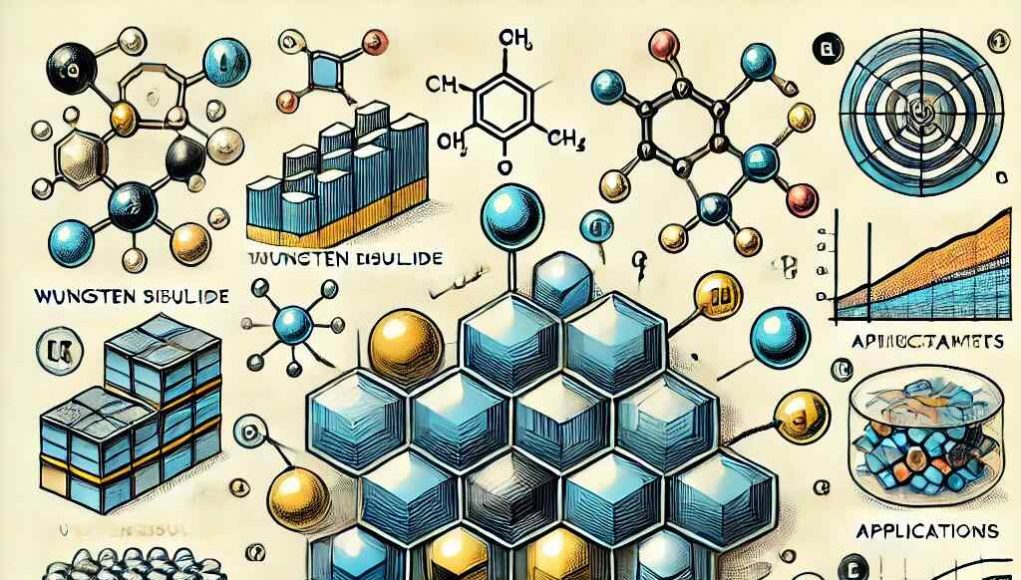Tungsten disulfide (WS2) is classified as a Transition Metal Dichalcogenides (TMDs). TMDs are considered to be layered materials with a chemical formula of MX2 where M is a transition metal and X is a chalcogen like Sulphur, Selenium and more.
The TMDs have a general formula of X-M-X structure with a layer of M atoms sandwiched between two layers of X atoms. The bonds within the layers are strong covalent bonds and the layers are held together by weak Van der Waals forces. The adjacent layers can easily slide past each other when a shear force is applied. This gives WS2 lubricating properties.
Lubrication is required to reduce friction and wear and improve the longevity of moving parts in a machinery. WS2 is used as a dry lubricant and allows safe and reliable operation of machinery. Tungsten disulfide (WS2) nanopowder can be used to avoid direct contact between the two surfaces in relative motion and also prevent corrosion.
WS2 occurs naturally as a rare mineral Tungstenite. WS2 can be used for solid lubrication in high temperature, high pressure, high load and high vacuum conditions. It has a very low coefficient of friction of 0.03 in static applications and 0.07 in dynamic applications.
WS2 is one of the most lubricious materials known. It is known for its properties like high load rating, long wear life, no drag and non-sticking. It can take loads up to 300,000 PSI which is higher than any other lubricant.
Characteristics of WS2
- WS2 is a dry lubricant and it has the capability to get deposited on the surface in the form of a binding film.
- WS2 can maintain chemical stability and hardness even at elevated temperatures. In the ambient atmosphere it can work effectively as a lubricant from -273° C to 650° C. In vacuum it can work in a temperature range of – 188° to 1316° C.
- It has the ability to form a bond with the surface at temperature which would not produce dimensional changes in the metal surface.
- It has the ability to prevent the corrosion of the metal surface even if it is applied as a thin film. It is relatively easy to apply.
- It has a low coefficient of friction and it can be added to metal powders to obtain a stable coefficient of friction.
- It can be used as an additive in grease and lubricating oils to improve the lubrication and extreme pressure properties.
- It has a long wear life in dry environments and its lubricity can last for many cycles.
Applications
- The space applications have harsh conditions like alternating temperature, high vacuum and strong irradiation limits and in such situations long-life of lubricant is also required. WS2 is widely used in space applications due to excellent lubricating and physicochemical properties. WS2 is known for its long service life in space.
- Due to its properties WS2 is widely used as a lubricant in a wide range of applications. It is used in industries such as automotive, electronics and more. WS2 nanoparticles are suitable for use in extreme conditions like energy storage systems.
- It can be added to composites and coatings to improve the lubricating properties and benefit the applications. It is used as a protective coating for many products.
- It can be added in the casting process to give certain lubricating properties to the metal surface. It has an excellent adsorption capacity on the metal surface.
- It helps to reduce friction and energy loss thereby improving the performance of machinery. It helps to improve the life of the components.
Synthesis of WS2
WS2 nanopowders can be synthesised using the Chemical Vapour Deposition method. The decomposition of Tungsten Hexacarbonyl precursor is conducted in a temperature range of 420° C – 1000° C in a reactor.
The evaporation temperatures used are between 80° C – 110° C with flowing He gas at a rate of 2000 cc/min – 4000 cc/min. This process takes place in a bubbler and after evaporation of the precursor it is mixed with the flow of the incoming gas which is also heated to the same temperature.
This mixture of carrier gas and the precursor vapour passes through a tube and enters a tubular reactor.. Two temperature zones are maintained here, hot and cold.The chamber to collect the nanoparticles is placed in the upper zone.
Pure crystalline WS2 nanoparticles form with excess of Sulphur. The powder is evaporated at a temperature of 200° C to remove the excess Sulphur. It is then condensed in the cold zone of the reactor to get WS2.
Follow Technoroll for more!





